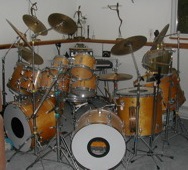I’m driving through Wyoming, and the trip has gotten weird.
Four months ago my soon-to-be 21-year-old daughter’s cute-Ute second-generation Rav4 got rear-ended and totaled on I-70 west of Denver. Now I’m headed back to Colorado’s Front Range, this time in a larger, third-gen Rav4. The market’s better for buyers in the Salt Lake corridor, Utah’s Front Range equivalent. As I did three years prior, I flew over, hit the dealer by noon and the road an hour later. Depending upon the route—the longer, more scenic Colorado route, affording an apre-dinner swim/soak at Glenwood Hot Springs, or the shorter route across southern Wyoming—I arrive home either 15 or 18 hours later, having inaugurated the vehicle. After taking the Rav up to 95mph, I set the cruise control at 82 (the posted limit is 75).
Southern Wyoming means I-80, a trucker’s road. The drive has a unique rhythm: approach a tractor-trailer rig from behind, set blinker and pass left, reset blinker, slide right, repeat. Sometimes I pass strings of trucks coupled by their slipstreams. Invariably, they glimmer in all the headlights, as if their every surface has been polished.
I brought a few CDs along for the drive, including a 1994 Windham Hill sampler. The sampler contains 46 song excerpts from their catalog plus one or two full-length songs. Without exception, all I know of each artist and song is its CD snippet. The CD has its own overall shape, making it an “album” all its own.
Track 27 captures me; it’s mesmerizing. An instrumental augmented by a 16 bar vocalization in a language I cannot understand—if it’s a language at all; for all I know it’s simply a syllabled melody. As the excerpt fades, I discern it shift into what I’ve since learned is the entire balance of the tune; the vocalization appears only during this first minute.

Poking the reverse scan button, it played again. Again I poked reverse scan, this time attempting to force the playback into proper timing, as if the ditty were a perfectly timed 24 bar loop. I’m interested in about 54 seconds of this 60 section excerpt. I played fusion drumset for twenty years, and it didn’t take long for me to find the correct timing: on the 3rd 16th-note upbeat (counted one-ee-and-uh two-ee-and-uh-three-ee-and-UH) I’d depress the button with percussive physicality, the wrist-arm followthrough much like when crashing a cymbal—and the loop played in perfect tempo.
For hours, around dozens of trucks, for hundreds of miles.
Now, I can’t leave things alone; I must make meaning of them. Since my parents died and my entry into patient advocacy, I often find my thoughts enmeshed in things related to all this. I tried to decipher the vocalization. Here’s what I made of it:
Be Nanny
Nanny nay-nay
Nannay
Be—you know?
Nanny
Oh, no no
Nannay
Be—you know?
I’m sure that this is not what’s enunciated. Since writing Notes from the Waiting Room: Managing a Loved One’s (End of Life) Hospitalization it takes very little for me to slip into ruminations about my parents’ demises and my subsequent patient-family advocacy work (a result of that existential harm I talk about). When zoning on cross-country drives this mindset takes over. (I have another metaphor for the mindset, but that’s an entirely different story.)
So what meaning do I make of my meaning? A continuum. A feminine continuum.
Be Nanny. My grandma. My mom, grandma to my daughter. My wife, grandma-to-be someday. My daughter, grandma when I’m long gone.
Nanny Nay Nay. Our role as patient advocates concerned with minimizing and mitigating risks to our hospitalized loved ones. Nanny, no matter our gender. Nay Nay; refusing to accept systemic shortcuts and shortcomings.
Oh, no no. Exactly what we think and feel time and again on the spur of every untoward moment.
Nannay. A hurt one’s lamenting, emphatic call for our involvement
Be—you know? We must be this role.
And so I kept at the repeat button, on the upmost upbeat, at full volume, for hours, and hundreds of miles. Anticipating the patient activist leadership summit at IHI.
The track is Sobre o Mar (Upon the Sea), from Paradise Station by Brazilian guitarist Torcuato Mariano, audio here. For those in the musical know and familiar with the coda to the Pat Methey Group’s Phase Dance (1978), Torcuato seems to be in conversation. PMG’s overlay with my mental musings around patient advocacy is yet another, more private story. [update: via an exchange with Torquato on MySpace I’ve learned that indeed the vocalizations are phonemes.]
